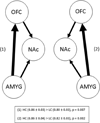Effective connectivity of a reward network in obese women
- PMID: 19467298
- PMCID: PMC3441054
- DOI: 10.1016/j.brainresbull.2009.05.016
Effective connectivity of a reward network in obese women
Abstract
Exaggerated reactivity to food cues in obese women appears to be mediated in part by a hyperactive reward system that includes the nucleus accumbens, amygdala, and orbitofrontal cortex. The present study used functional magnetic resonance imaging (fMRI) to investigate whether differences between 12 obese and 12 normal-weight women in reward-related brain activation in response to food images can be explained by changes in the functional interactions between key reward network regions. A two-step path analysis/General Linear Model approach was used to test whether there were group differences in network connections between nucleus accumbens, amygdala, and orbitofrontal cortex in response to high- and low-calorie food images. There was abnormal connectivity in the obese group in response to both high- and low-calorie food cues compared to normal-weight controls. Compared to controls, the obese group had a relative deficiency in the amygdala's modulation of activation in both orbitofrontal cortex and nucleus accumbens, but excessive influence of orbitofrontal cortex's modulation of activation in nucleus accumbens. The deficient projections from the amygdala might relate to suboptimal modulation of the affective/emotional aspects of a food's reward value or an associated cue's motivational salience, whereas increased orbitofrontal cortex to nucleus accumbens connectivity might contribute to a heightened drive to eat in response to a food cue. Thus, it is possible that not only greater activation of the reward system, but also differences in the interaction of regions in this network may contribute to the relatively increased motivational value of foods in obese individuals.
Conflict of interest statement
The authors declare that they have no competing financial interests.
Figures




References
-
- Aron A, Fisher H, Mashek DJ, Strong G, Li H, Brown LL. Reward, motivation, and emotion systems associated with early-stage intense romantic love. J. Neurophysiol. 2005;94:327–337. - PubMed
-
- Balleine BW, Killcross S. Parallel incentive processing: an integrated view of amygdala function. Trends Neurosci. 2006;29(5):272–279. - PubMed
-
- Bentler PM, Chou CP. Practical issues in structural modeling. Socio. Meth. Res. 1987;16(1):78–117.
-
- Berridge KC. Motivation concepts in behavioral neuroscience. Physiol. Behav. 2004;81:179–209. - PubMed
Publication types
MeSH terms
Grants and funding
LinkOut - more resources
Full Text Sources
Medical

